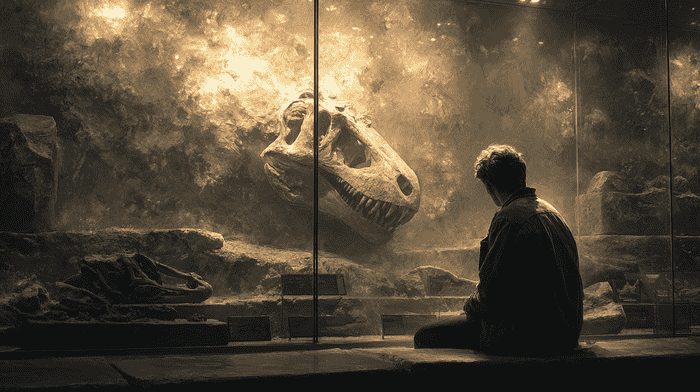The Bible and the Word “Dinosaur”
Let’s clear one thing up from the start: you won’t find the word “dinosaur” anywhere in the Bible. Not in Genesis, not in Job, and not even tucked away in some obscure prophetic vision. That’s because the word simply didn’t exist yet.
The term “dinosaur” was coined in 1842 by British paleontologist Richard Owen. That’s nearly two thousand years after the biblical texts were written. So it would be historically inaccurate to expect the biblical authors to use a word that hadn’t been invented yet.
But just because the term isn’t there doesn’t mean the Bible is silent on large, awe-inspiring creatures. It absolutely isn’t.
The Hebrew Scriptures (what Christians call the Old Testament) speak of several mysterious beasts, some described with detail, others more symbolically. The most famous are probably Behemoth and Leviathan, both appearing in the book of Job. These descriptions have led many to wonder: were these creatures poetic images, real animals, or something else entirely?
We’ll dive into those creatures shortly, but for now, it’s important to remember this: the Bible is not a science textbook, nor does it claim to be. It doesn’t set out to document every species God created. Its focus is on the relationship between God and humanity, not fossil records or geological timelines.
That said, Scripture is not in conflict with the natural world. As Psalm 19:1 puts it:
“The heavens are telling the glory of God; and the firmament proclaims his handiwork.” (Psalm 19:1, NRSV-CE)
In other words, both Scripture and nature point to the same Creator. The Bible might not give us a paleontology lesson, but it invites us to stand in awe of the One who shaped the universe, from stars to sea creatures, from sparrows to (possibly) sauropods.
Ancient Creatures in Scripture
If the Bible doesn’t mention dinosaurs by name, could it still describe them?
In the book of Job, we meet two of the most puzzling creatures in all of Scripture: Behemoth and Leviathan. They’re massive. Terrifying. Uncontrollable. Most importantly, they are used by God to show Job just how vast and untamable creation really is.
God describes Behemoth like this:
“Look at Behemoth, which I made just as I made you; it eats grass like an ox. Its strength is in its loins, and its power in the muscles of its belly…
It is the first of the great acts of God—only its Maker can approach it with the sword.”
(Job 40:15–16, 19, NRSV-CE)
Some say this sounds like a hippopotamus or elephant, but others point out the details (like its tail “as stiff as a cedar” (v. 17)) and wonder if this was something bigger, something extinct. Possibly even a dinosaur-like creature.
Then there’s Leviathan:
“Can you draw out Leviathan with a fishhook, or press down its tongue with a cord?
…Its sneezes flash forth light, and its eyes are like the eyelids of the dawn.
From its mouth go flaming torches; sparks of fire leap out.”
(Job 41:1, 18–19, NRSV-CE)
A crocodile? A mythic sea dragon? A poetic image of chaos? All of these have been suggested, but regardless of what Leviathan “really” was, the point stands: these creatures were beyond human power. Only God could tame them.
Here’s why that matters. Whether you believe Behemoth and Leviathan were actual animals or symbolic descriptions, the theological message is the same. God is reminding Job (and us) that the created world is vast, wild, and not ours to control. In a moment of suffering and confusion, Job is being shown the sheer scale of God’s handiwork.
And that, perhaps, is the bigger takeaway: when we try to shrink the Bible into a field guide of extinct species, we risk missing the deeper point. These creatures are not just curiosities, they’re theological signposts. They exist in Scripture to turn our gaze upward, not just backward in time.

Get Closer to God Today
4.9
Average Rating
|Over 5 Million Downloads
Did God Create Dinosaurs?
Here’s where things tend to get a little heated. Did humans and dinosaurs ever walk the earth at the same time? And if so, why doesn’t the Bible spell it out?
There are two main camps within the Christian world when it comes to this question, and both are trying to take Scripture seriously, just from very different angles.
1. The Young-Earth View: They Were Created Together
Many Christians, especially in Young Earth Creationist circles, believe that dinosaurs were created on Day Six of creation: “Let the earth bring forth living creatures of every kind” (Genesis 1:24, NRSV-CE). That includes land animals… and if dinosaurs are land animals, then in this view, they were right there from the start.
According to this timeline, dinosaurs lived alongside early humans, and most of them died out during or shortly after the Flood. Some even interpret the Ark story to include them:
“Of the animals that are not clean, two and two, male and female, went into the ark with Noah…”
(Genesis 7:8–9, NRSV-CE)
It’s a bold claim, and one supported by creationist museums, ministries, and books that argue dinosaur fossils are the result of rapid burial during a global flood. They’ll sometimes point to dragon legends or strange carvings in ancient temples as possible “evidence” of human-dinosaur encounters.
Is it persuasive? For some, yes. Especially if your starting point is that the Earth is only a few thousand years old, and Scripture is read as a literal, day-by-day account of creation history.

2. The Old-Earth View: Dinosaurs Came Long Before Us
Others (including many Christians in scientific fields) see the Earth as billions of years old, based on geology, astronomy, and radiometric dating. From this view, dinosaurs lived and went extinct long before humans ever appeared.
That doesn’t mean these Christians are throwing out Genesis. Instead, they read the creation story as theological poetry, a divinely inspired account of who made the world and why, not necessarily how or when in scientific terms. Genesis 1 becomes less about dating fossils and more about declaring the goodness and order of creation.
In this framework, dinosaurs still fit into God's story, just don’t overlap with human history. They’re part of the vast pre-human past that Psalm 104:24 points to:
“O Lord, how manifold are your works! In wisdom you have made them all; the earth is full of your creatures.”
(Psalm 104:24, NRSV-CE)
In the end, whether you lean young-earth or old-earth, it’s worth remembering this: dinosaurs aren't a threat to faith. If anything, they challenge us to ask deeper questions: about God’s timing, God’s power, and how we interpret Scripture with both faith and humility.
Dinosaurs and the Bible: Theology Above Paleontology
Dinosaurs are fascinating. It’s easy to get swept up in the timelines, the fossils, the debates, but when it comes to the Bible, the most important question is about the when, it’s about the what. What do they tell us about God?
This is where theology gently but firmly steps ahead of science.
When God responds to Job from the whirlwind (Job 38–41), He doesn’t give answers about suffering, timelines, or even justice. Instead, He points to creation: mountains, weather patterns, lions, wild oxen, and yes, creatures like Behemoth and Leviathan.
That’s because God's creation is a stage for His power, wisdom, and glory. That’s the deeper point of these passages.
“Who has put wisdom in the inward parts, or given understanding to the mind?”
(Job 38:36, NRSV-CE)
The Bible constantly invites us to look at creation and see the Creator. Dinosaurs, whether mentioned directly or not, fit squarely into that. They’re not just prehistoric curiosities. They’re part of a much bigger picture, a reminder that God’s creative power is vaster than we tend to imagine.
In fact, when you stop and think about it, it’s kind of staggering: God didn’t just create what we see now. He created entire worlds that came and went long before we did. That’s not a distraction from the gospel; it’s a testament to God’s greatness.
Theologian John Piper once reflected that dinosaurs might exist “simply to make us stand in awe.” And he wasn’t wrong. They remind us we’re not the center of the story. God is. Always has been.
So yes, the Bible is silent on fossil layers and evolutionary theory. But it is loud when it comes to this: all of creation, including the parts we don't fully understand, points to the glory of God.
What Scripture Doesn’t Tell Us
By now, you’ve probably noticed something: the Bible gives us glimpses of massive, mysterious creatures, but it doesn’t offer a comprehensive dinosaur guide.
The Bible isn’t trying to answer every scientific question we might ask in the 21st century. It doesn’t map out geological epochs or tell us how many species lived before the Flood. That was never its purpose. Its aim is eternal, not encyclopedic.
“But these are written so that you may come to believe that Jesus is the Messiah, the Son of God, and that through believing you may have life in his name.”
(John 20:31, NRSV-CE)
If we come to Scripture expecting it to settle scientific debates, we might walk away disappointed. But if we approach it to know God, understand our place in His story, and live with wisdom and purpose, we’ll find everything we need.
Still, that doesn’t mean science and Scripture are enemies. There’s space for faithful Christians to explore the natural world, ask hard questions, and study fossils without undermining biblical truth. But we have to respect the limits of each.
Get Closer to God Today
4.9
Average Rating
|Over 5 Million Downloads
Final Bridging Faith and Science (Gracefully)
There’s a temptation, especially in Christian circles, to feel like we have to choose sides: either you believe the Bible, or you trust science. But that’s a false choice, and a pretty recent one.
Throughout history, many believers saw science not as a rival to faith but as a natural extension of it. After all, if God created the world, then studying it carefully is a form of worship, an act of reverence, not rebellion.
“Great are the works of the Lord, studied by all who delight in them.”
(Psalm 111:2, NRSV-CE)
When it comes to dinosaurs, Christians across the spectrum have reached different conclusions. Some believe they lived alongside humans. Others place them millions of years earlier. But in most cases, these differences come down to how we interpret the opening chapters of Genesis, not whether we believe them.
And that’s important. Because even when Christians disagree about the when, most agree on the why: all of creation, past and present, reveals the glory of God.
It’s also worth saying: faith and curiosity can coexist. You don’t have to have every answer to hold on to the truth. Some of the most faithful Christians I know are also scientists, paleontologists, or teachers who wrestle with this exact tension every day.
The challenge is to hold these things with grace, not to dismiss those who think differently, but to stay rooted in Scripture while remaining open to learning more about the world God made.
Explore More
If this topic stirred up questions or just made you wonder what else the Bible might be hinting at, Bible Chat is here to help. From the mystery of Behemoth to the meaning of creation days, you’ll find faithful, thoughtful answers rooted in Scripture. Dive deeper into passages like Job 40–41, the Genesis creation account, and more with the Bible Chat App.
References
- The Holy Bible, New Revised Standard Version, Catholic Edition. (1996). Ignatius Press.
- Walton, J.H., 2009. The Lost World of Genesis One: Ancient Cosmology and the Origins Debate. Downers Grove, IL: IVP Academic.
- Miller, J.V. and Soden, J.M., 2012. In the Beginning... We Misunderstood: Interpreting Genesis 1 in Its Original Context. Grand Rapids, MI: Kregel Publications.
Image Sources: Midjourney.com










